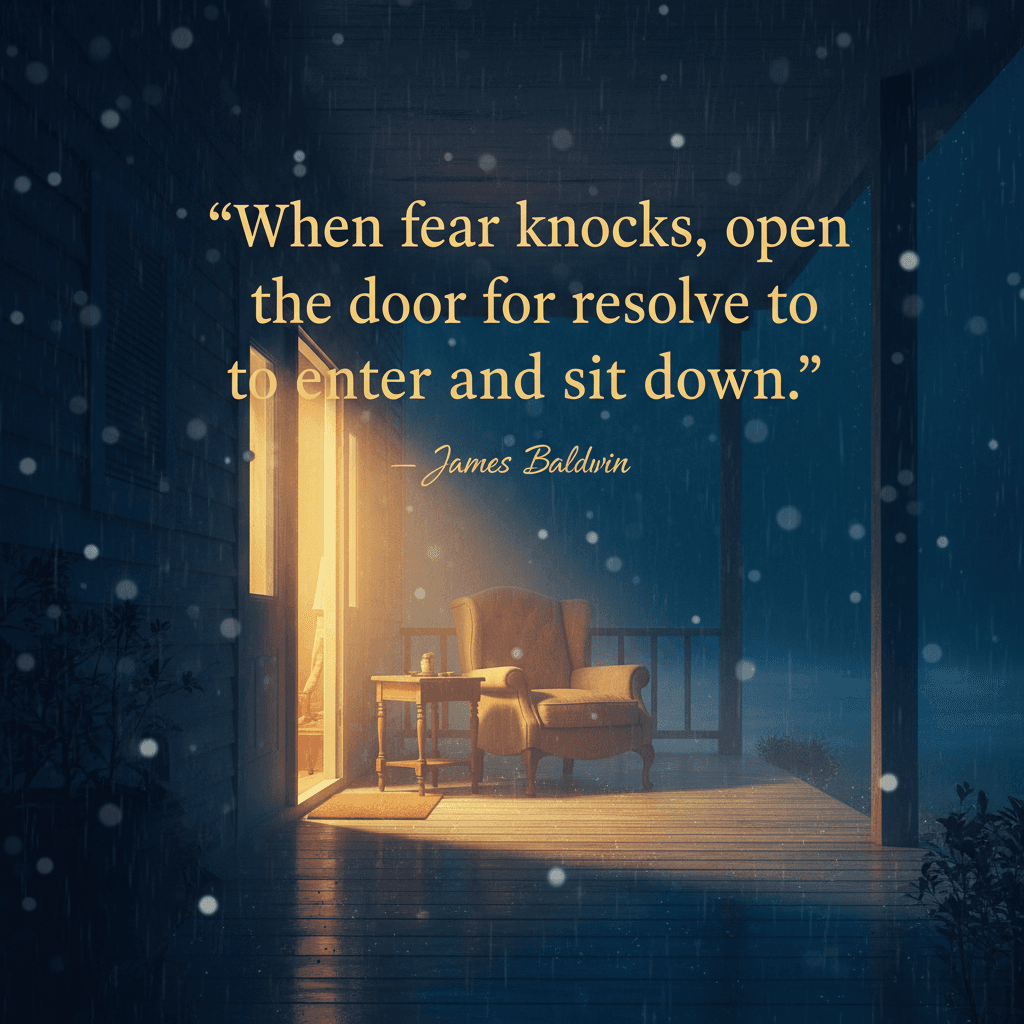Answering Fear with Seated, Steady Resolve

When fear knocks, open the door for resolve to enter and sit down. — James Baldwin
Opening the Door: A Metaphor of Hospitality
Baldwin’s sentence reframes courage as an act of welcoming rather than warring. When fear knocks, we do not barricade ourselves; we turn the handle and choose what enters with it. By inviting resolve to “sit down,” the line suggests more than a burst of bravery—it calls for a settled guest, a presence that stays when the initial shock fades. In this way, composure becomes furniture, not fireworks. Consequently, fear is neither demonized nor allowed to dominate the room. It announces danger; resolve arranges the chairs. The image turns courage into a practiced hosting: we greet the alarm, then make space for a steadier companion whose quiet posture sets the tone for how we will act.
Baldwin’s Context: Witnessing in the Face of Terror
From this image, it is a short step to Baldwin’s world, where the stakes were public and lethal. In The Fire Next Time (1963), he insists on looking squarely at America’s racial nightmare without surrendering to it. Opening the door, for him, meant naming realities—lynching, police violence, and the psychic contortions of prejudice—while refusing paralysis. Moreover, Baldwin’s witness was not mere defiance; it was moral steadiness. Essays like Notes of a Native Son (1955) show a discipline of staying seated at the table of truth even when rage or despair might upend it. Thus, the line’s domestic calm—resolve taking a chair—echoes his vocation: remain, see, speak, and act without flinching.
From Avoidance to Approach: The Psychology of Courage
Psychologically, the sentence moves us from avoidance to approach. Fear’s knock is a real signal; yet the choice is whether to flee or to engage with values intact. Acceptance and Commitment Therapy (Hayes, Strosahl, and Wilson, 1999) advises opening the door to uncomfortable emotions while committing to purposeful action—precisely the arc Baldwin sketches. In this light, resolve is not the absence of fear but a companion that coexists with it. Naming the feeling reduces its grip (Lieberman et al., PNAS, 2007), while an approach mindset shifts attention from threat to meaning. The result is agency: gait steady, gaze oriented, one deliberate step after another—not because fear has left, but because resolve has sat down.
The Quiet Power of Sitting: A Civic Resonance
Historically, “sit down” reverberates with the civil-rights sit-ins—Greensboro, 1960—where stillness itself became strategy. Students took seats at segregated counters and, by refusing to move, transformed furniture into a theater of conscience. Their composure outlasted jeers, arrests, and blows; their posture made moral claims visible. Seen this way, Baldwin’s phrase is not only private counsel but public choreography. Resolve, seated, is not passive; it is anchored. The body occupies space truthfully, daring the world to reckon with that truth. The gesture teaches that perseverance can be quieter than fury yet harder to dislodge.
Practicing a Seated Resolve: Small, Teachable Moves
Consequently, the metaphor becomes a method. First, name the knock: “I feel fear about X.” Then seat resolve with an if–then plan—implementation intentions (Gollwitzer, 1999): “If I feel my chest tighten before the meeting, then I will breathe for ten counts and state my proposal.” Add a brief script of values—two sentences that answer why this matters. Next, stabilize the posture. Place both feet on the ground, relax the jaw, and visualize the chair beneath you; a bodily anchor often steadies the mind. Finally, act in the smallest meaningful unit—send the email, make the call, step to the podium. Each small action teaches the nervous system that resolve belongs in the room.
From Personal Poise to Shared Courage
Finally, seated resolve scales from the self to the collective. Baldwin’s public dialogues—culminating in the Cambridge Union debate with William F. Buckley Jr. (1965)—modeled how conviction holds its chair amid hostile narratives. When one person sits calmly in truth, others find their place settings. Thus, the invitation is communal: arrange spaces where fear can be spoken and resolve can remain. In teams, classrooms, and neighborhoods, the practice is the same—open the door, let the alarm speak, and then grant resolve a durable seat. Over time, that chair becomes part of the room’s architecture.